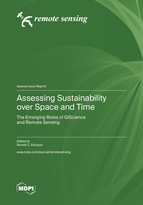Assessing Sustainability over Space and Time: The Emerging Roles of GIScience and Remote Sensing
A special issue of Remote Sensing (ISSN 2072-4292). This special issue belongs to the section "Urban Remote Sensing".
Deadline for manuscript submissions: closed (31 December 2022) | Viewed by 59474
Special Issue Editor
Interests: sustainability science; land change science; forest transition theory; forest monitoring; sustainable forest management; ecosystem services; climate change; GIScience and remote sensing
Special Issues, Collections and Topics in MDPI journals
Special Issue Information
Dear Colleagues,
The formulation of the 17 Sustainable Development Goals (SDGs) is a major leap towards humankind’s quest for sustainability. The SDGs now collectively serve as the platform for global development—a platform which now helps to guide current actions and shape visions for a sustainable future. There is a need to track the spatiotemporal dynamics of progress towards the SDGs in particular and sustainability in general, not only at the global and national scales, but also at the subnational and landscape levels. The advances in geospatial technologies (GIS and remote sensing), including the increasing availability of geospatial data, can help in this regard.
This Special Issue will bring together novel contributions on the assessment of sustainability over space and time. Contributions that highlight or explore the role or potential contribution of geospatial (GIS and remote sensing) data, tools, and techniques in the assessment of sustainability over space and time are very much welcome. Contributions that do not necessarily employ geospatial data, tools, and techniques but consider the space and time dimensions of sustainability are also very much welcome.
Contributions can be in the form of:
- Articles;
- Reviews;
- Perspectives and Insights.
Dr. Ronald C. Estoque
Guest Editor
Manuscript Submission Information
Manuscripts should be submitted online at www.mdpi.com by registering and logging in to this website. Once you are registered, click here to go to the submission form. Manuscripts can be submitted until the deadline. All submissions that pass pre-check are peer-reviewed. Accepted papers will be published continuously in the journal (as soon as accepted) and will be listed together on the special issue website. Research articles, review articles as well as short communications are invited. For planned papers, a title and short abstract (about 100 words) can be sent to the Editorial Office for announcement on this website.
Submitted manuscripts should not have been published previously, nor be under consideration for publication elsewhere (except conference proceedings papers). All manuscripts are thoroughly refereed through a single-blind peer-review process. A guide for authors and other relevant information for submission of manuscripts is available on the Instructions for Authors page. Remote Sensing is an international peer-reviewed open access semimonthly journal published by MDPI.
Please visit the Instructions for Authors page before submitting a manuscript. The Article Processing Charge (APC) for publication in this open access journal is 2700 CHF (Swiss Francs). Submitted papers should be well formatted and use good English. Authors may use MDPI's English editing service prior to publication or during author revisions.
Keywords
- Sustainability
- Sustainability assessment
- Sustainable development
- Sustainable development goals
- SDGs
- Landscape sustainability
- Urban sustainability
- GIScience
- GIS
- Remote sensing
- Earth observations
- Spatiotemporal analysis
- Spatial thinking
- Geospatial data
- Scale
- Space–time
- Sustainability indicators
- SDG indicators
- Land change
- Land use/land cover, etc.






